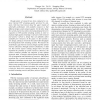Free Online Productivity Tools
i2Speak
i2Symbol
i2OCR
iTex2Img
iWeb2Print
iWeb2Shot
i2Type
iPdf2Split
iPdf2Merge
i2Bopomofo
i2Arabic
i2Style
i2Image
i2PDF
iLatex2Rtf
Sci2ools
ICDCS
2009
IEEE
2009
IEEE
Towards Optimal Resource Utilization in Heterogeneous P2P Streaming
Though plenty of research has been conducted to improve Internet P2P streaming quality perceived by endusers, little has been known about the upper bounds of achievable performance with available resources so that different designs could compare against. On the other hand, the current practice has shown increasing demand of server capacities in P2P-assisted streaming systems in order to maintain high-quality streaming to end-users. Both research and practice call for a design that can optimally utilize available peer resources. In the paper, we first present a new design, aiming to reveal the best achievable throughput for heterogeneous P2P streaming systems. We measure the performance gaps between various designs and this optimal resource allocation. Through extensive simulations, we find out that several typical existing designs have not fully exploited the potential of system resources. However, the control overhead prohibits the adoption of this optimal approach. Then, we design...
| Added | 19 May 2010 |
| Updated | 19 May 2010 |
| Type | Conference |
| Year | 2009 |
| Where | ICDCS |
| Authors | Dongyu Liu, Fei Li, Songqing Chen |
Comments (0)

